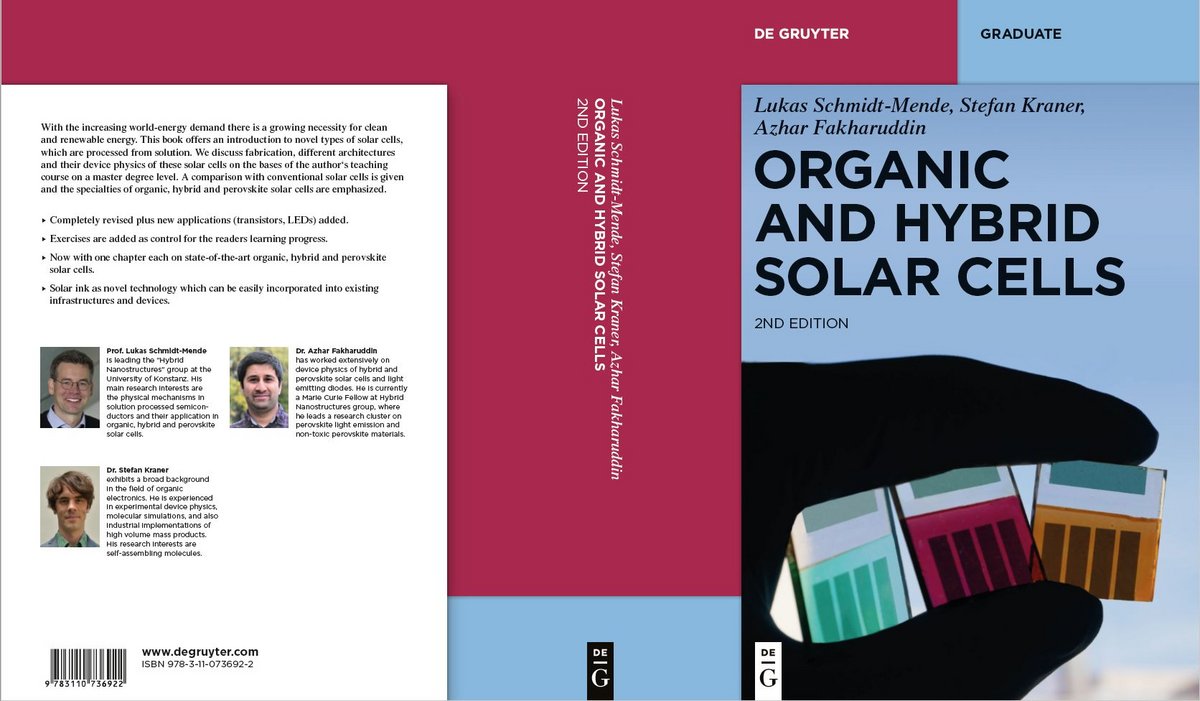
Organic and Hybrid Solar Cells
Our 2nd edition of the text book "Organic and Hybrid Solar Cells" based on the lecture "The Physics of Organic and Hybrid Solar Cells" given here at the University of Konstanz is now available at De Gruyter.
"Organic and Hybrid Solar Cells" is an introduction to the field of organic and hybrid photovoltaics. The authors take a focused approach to provide the reader with an overview of the most relevant scientific background as well as current research developments. Starting with a basic introduction to semiconductor physics, the book discusses inorganic and organic semiconductors and junctions, working mechanisms and architectures of organic, dye-sensitized, hybrid and perovskite solar cells, characterization techniques, and gives insights into fabrication, device lifetime and commercialization aspects of these exciting photovoltaic materials.
- Based on a lecture by the authors for master students.
- Detailed introduction to organic, hybrid and perovskite solar cells – alternatives for low-cost, light-weight and flexible renewable energy.
- Covering fully organic, hybrid and dye-sensitized, and perovskite solar cells.
- Explaining working mechanisms and characterization techniques.
- Giving an excellent overview over these emerging technologies.
- After reading this book the reader should be able to understand current literature on this topic.
- Now with additional exercises for self-checking the learning progress.
We are happy for comments and suggestions for improvements. Please also let us know if you spot errors, that we can list all known errors here and improve the book further.
If you are interested, you can still find the 1st edition of the book at De Gruyter.
Thanks for your help!
Known errors in the book (1st edition from 2016) and their corrections
You can download the list of this known errors including corrected figures here.
| Page No. | Error description | Corrected Version |
|---|---|---|
| p. 45 | Fig. 2.27: The presented molecular orbitals are wrong. | Fig. 2.27 |
| p. 63 | Eqn. 2.75: Förster radius factor 1000 too large. | $R_0^6=\frac{9 Q_0 \kappa^2 J \ln{10}}{128 \pi^5 n^4 N_A}$ |
| p. 77 | Eqn. 2.98/2.99 (Bässler model) | $\mu(\hat{\sigma},\sigma_{\Gamma},E) for $\sigma_{\Gamma}\ge 1.5$ $\mu(\hat{\sigma},\sigma_{\Gamma},E) for $\sigma_{\Gamma}< 1.5$ |
| p. 84 | Eqn. 2.110/111 (Poisson Eqn.) | In n-type region: $\frac{d^2 \Phi}{d x^2}=-\frac{q}{\epsilon} N_d$ for $x>0$ In p-type region: $\frac{d^2 \Phi}{d x^2}=\frac{q}{\epsilon} N_a$ for $x<0$ |
| p. 113 | Fig. 3.14, Figure Caption | Replace $R_S$ with $R_{SH}$ |
| p. 129 | Fig. 3.28 | (c) Time: 57.3 fs, (d) Time 98.7 fs |
| p. 142 | Fig. 3.40 (b), Color code of lines in graph are inverted compared to legend. | Fig. 3.40 |
| p. 181 | Fig.3.69, Color of lines swapped (dark blue: forward (bottom curve), bright blue: reverse (top curve) as in legend. | Fig. 3.69 |
| p. 198 | Eqn. 4.5 (reciprocity relation): Replace q with J. | $J_0 EQE_{EL}(\lambda)= J EQE_{PV}(\lambda) I_{BB}(\lambda)$ |
| p. 204 | Fig. 4.5: Sheet resistance measurements | Current is applied between the outer two pins, whereas the voltage is measured across the inner contacts. (Same is valid for text above Figure 4.5) |
| p. 218 | Eqn. 4.29 (and text), replace A with Abs. | $IQE(\lambda)=\frac{EQE(\lambda)}{Abs(\lambda)}$ |
| p. 223 | Eqn. 4.35, replace "q" with "-". | $n_{int}=N_C \exp \left( -\frac{E_{gap}}{2k_B T} \right)$ |
| p. 223 | Eqn 4.38, missing R. | $\frac{1}{q}\frac{\partial}{\partial z} J(z) =PG-(1-P)\cdot R$ |
| p. 224 | Eqn 4.43/44/47 and text | replace log with ln. |
| p. 235 | Tab. 4.1 (Symbol for Capacitance incorrect) | Tab. 4.1 |
